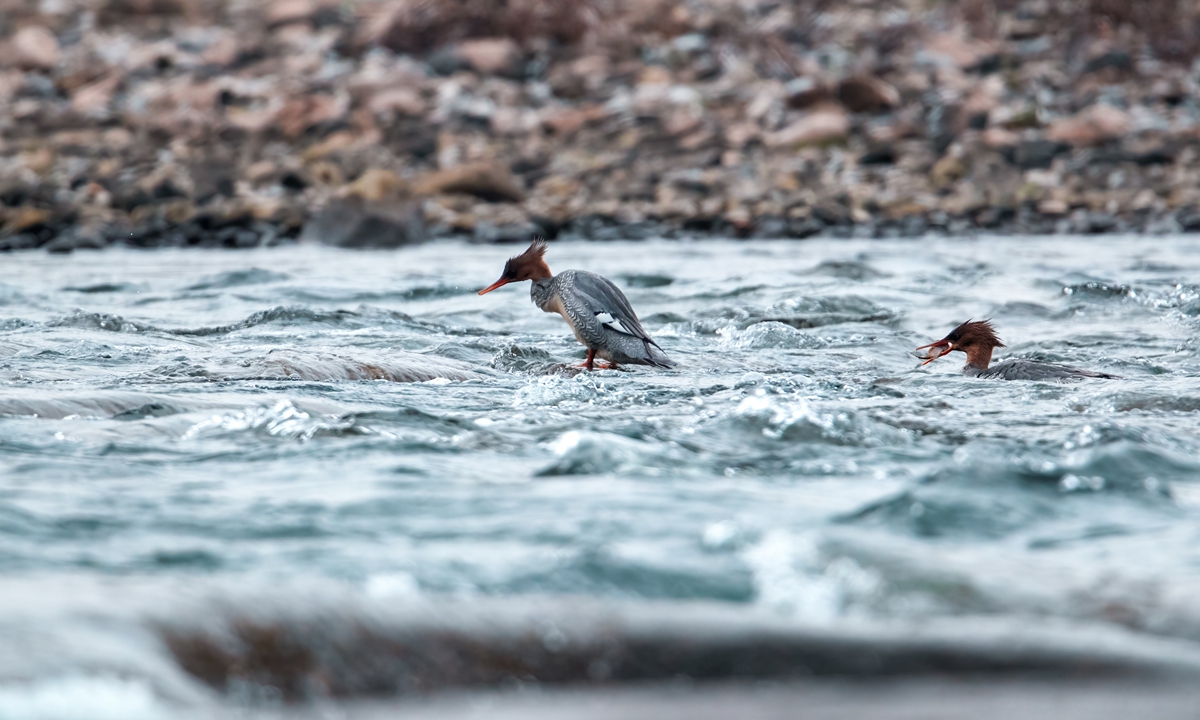
Birds hunt on a tributary of the Yangtze River in Chongqing. Photo: IC

The Baisha Yangtze River Bridge in Chongqing Photo: IC
"This bridge reflects the concept of a 'shared life community,'" said Liu Jianhu, a Chinese aquatic biologist who works to conserve the fishery resources of the Yangtze River, describing a new bridge in Chongqing Municipality that was built without piers between its two abutments in order to preserve the local habitat of aquatic creatures.
Two piers, one problem Due to its location in a nature reserve along the upper reaches of the Yangtze River, it took six years of planning and construction before the Baisha Yangtze River Bridge at the Jiangjin district in Chongqing could open in January.
Species unique to China such as the Yangtze sturgeon, a national first-class protected animal, and the Chinese-high fin banded shark use this area as spawning grounds as well as a place to live through winter.
The original plan for the bridge in 2016 - a suspension bridge with the main bridge spanning 590 meters above the water - included 15 piers, two of which would have supported the bridge in the middle of the river.
The bridge was designed to have three 60-meter bridge approaches. According to an engineer surnamed Wu with T.Y.Lin International Group, the company that designed the bridge, this was a "pretty standard" design.
However, this design became an issue as the two piers in the river raised ecological concerns.
"The most important issue is that they would have taken up space where fish feed," Liu told the Global Times.
"We won't get far if we sacrifice the natural ecology just to meet the need of transportation."
"We have to change. Taking care of the Yangtze River is also our responsibility," said Wu.
"Improving the design was difficult, but it was not [as difficult as] rocket science."
In addition to the precious Yangtze sturgeon, the nature reserve is the exclusive home to a total of more than 70 rare fish species. The reserve was established by the State Council in 2005 to enhance the preservation of these creatures in the provinces of Sichuan, Yunnan and Guizhou and the Municipality of Chongqing.
The cost of protection
The bridge's design group consulted Liu and his research team on how to protect the local habitat in the construction zone.
They finally decided to remove the two piers in the river by expanding the bridge's approach span, and only keep one main bridge tower.
Liu told the Global Times that he was deeply moved that the design company sought out ecological advice during the early design phase. For him, this shows a social awareness of the importance of biodiversity preservation along the river.
"This made our goal to protect the river not just a point of interest for researchers, but also for designers and people," Liu said.
"It was a like an 'immunization shot' for long-term sustainability."
"It reflects a modernist design mentality that values the environment and sustainability. This sounds very noble, but it increases cost as more techniques and skills are required," Dylan Yang, an architect in Shanghai, told the Global Times.
According to Wu, the improved "pierless" bridge increased costs by tens of millions of yuan.
Besides solving the "piers" problem, Liu's evaluation report also detailed other issues such as an emergency plan to deal with construction accidents, such as harm to wildlife caused by explosions. During construction, an emergency water tank, rescue experts and medical supplies for fish were all on standby at the site.
The Mother River
Dubbed the "Mother River," the Yangtze River has long been the target of conservation efforts.
Taking the nature reserves along the upper reaches of the Yangtze River as an example, fishing resources were nearly depleted around 2012-13 due to overfishing.
In 2017, the Ministry of Agriculture and Rural Affairs of China issued a total ban on fishing in the aquatic life reserves in the Yangtze River Basin. It also strived to encourage fishermen at such reserves to withdraw from the industry in two years by providing them with policy and financial support.
"This has led to great change. When carrying out research in 2021, we saw an increase in the age of fish samples, which means the loss of mature fish due to fishing has been gradually curbed," said Liu.
In 2020, a 10-year plan to ban fishing in the Yangtze River was issued by the ministry.
"The decision brought hope to those flagship aquatic species in the river. If the environment improves, they will be able to increase on their own," Xu Dingping, a Yangtze River aquatic researcher, told the Global Times.
"The so-called ecological repair projects should be considered as ecological restoration projects, and should be systematically considered for the Yangtze River," Zhou Jinfeng, an insider at China's CBCGDF, a non-profit public foundation dedicated to biodiversity conservation, told the Global Times.
Linking to the Baisha industrial area to the east, the bridge has not only helped ease people's daily commute, but also brought commercial hope to local industries.
As a trip that used to take an hour only takes 10 minutes now, this has helped reduce logistic and transportation costs for enterprises.





